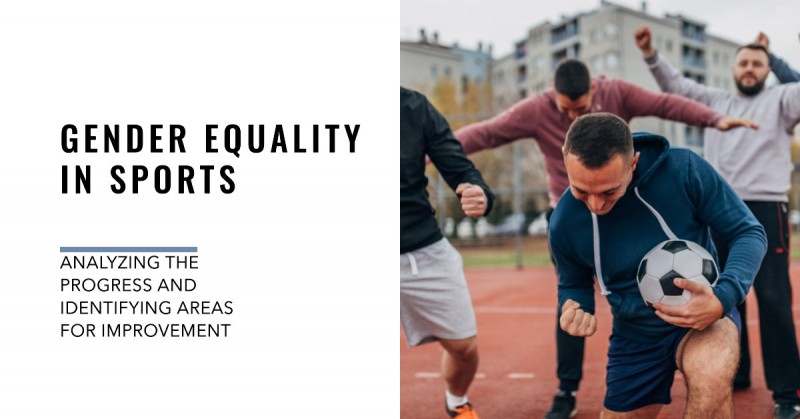
Sports have always been an arena dominated by men, but over the years, there has been a significant shift towards promoting gender equality in this field. Efforts have been made to bridge the gap and create opportunities for women to participate, compete, and excel in various sports. In this article, we will analyze the progress made towards achieving gender equality in sports and identify areas where further improvement is needed.
1. Introduction
Gender equality in sports refers to the fair and equal treatment of individuals regardless of their gender in all aspects of sports, including participation, pay, representation, and leadership roles. While progress has been made, there are still areas where further improvement is needed to create a truly inclusive sporting environment.
2. Historical Perspective
In the past, women's participation in sports was heavily restricted, with societal norms and gender stereotypes playing a significant role. However, the efforts of trailblazers like Billie Jean King, who defeated Bobby Riggs in the famous "Battle of the Sexes" tennis match, helped pave the way for change.
3. Breaking Barriers: Women in Sports
Women have shattered numerous barriers in sports, showcasing their talent and determination. Athletes like Serena Williams, Simone Biles, and Megan Rapinoe have not only achieved remarkable success but have also become symbols of empowerment and inspiration for aspiring female athletes worldwide.
4. Pay Disparity: Addressing the Wage Gap
One persistent issue in achieving gender equality in sports is the wage gap between male and female athletes. Despite achieving similar levels of success and recognition, female athletes often receive significantly lower pay and sponsorship opportunities compared to their male counterparts. Efforts must be made to bridge this gap and ensure equitable compensation for athletes irrespective of gender.
5. Representation and Media Coverage
The representation of female athletes in the media has improved over the years, but there is still a long way to go. Women's sports receive considerably less media coverage compared to men's sports, leading to limited exposure and fewer opportunities for sponsorship. Increased media coverage and highlighting women's achievements can help break stereotypes and encourage greater participation.
6. Access to Facilities and Resources
Equal access to sports facilities and resources is crucial for promoting gender equality. Many women and girls face challenges due to limited access to safe and well-maintained facilities. Ensuring equal access to resources, training opportunities, and funding can help level the playing field and foster greater participation.
7. Coaching and Leadership Opportunities
Gender disparity is also evident in coaching and leadership positions within sports organizations. Encouraging more women to pursue coaching careers and providing them with equal opportunities can help create role models and mentors for aspiring female athletes. Increasing the representation of women in decision-making roles is essential for shaping policies that promote gender equality.
8. Stereotypes and Gender Bias
Gender stereotypes and bias continue to affect women's participation in sports. Traditional notions that associate sports with masculinity can discourage girls from engaging in physical activities. Challenging these stereotypes and promoting inclusive messaging can encourage girls and women to pursue sports without fear of judgment or discrimination.
9. Promoting Girls' Participation in Sports
It is crucial to encourage girls' participation in sports from an early age. Providing access to sports programs in schools, promoting physical education, and offering diverse sporting options can help break gender barriers and foster a lifelong interest in sports.
10. Empowering Female Athletes
Empowering female athletes goes beyond providing equal opportunities. It involves creating a supportive and nurturing environment that addresses the unique challenges faced by women in sports, such as maternity leave policies, childcare support, and protection against harassment and abuse.
11. Overcoming Challenges: Intersectionality in Sports
Achieving gender equality in sports requires recognizing and addressing the challenges faced by individuals at the intersection of gender, race, and other identities. Intersectionality plays a crucial role in understanding the experiences and barriers faced by athletes belonging to marginalized communities.
12. Celebrating Success Stories
Highlighting success stories of female athletes across various sports can inspire the next generation. Recognizing their achievements and sharing their journeys can challenge societal norms and encourage more girls and women to pursue their dreams in sports.
13. Challenges Faced by Transgender Athletes
The inclusion of transgender athletes in sports has raised complex debates. Balancing fairness and inclusion is essential when establishing policies and guidelines that allow transgender athletes to compete while ensuring a level playing field.
14. Promoting Inclusivity: The Role of Sporting Organizations
Sporting organizations have a pivotal role to play in promoting gender equality. They must implement policies and initiatives that support equal opportunities, invest in women's sports, and foster an inclusive culture that values diversity.
15. The Way Forward
To continue progressing towards gender equality in sports, concerted efforts are needed from all stakeholders. This includes sporting organizations, athletes, fans, media, and society as a whole. By challenging existing norms, breaking down barriers, and working together, we can create a future where gender equality is the norm in sports.
Conclusion
Gender equality in sports is an ongoing journey, and while significant progress has been made, there are still areas that require attention and improvement. By addressing issues such as pay disparity, media representation, access to resources, and challenging stereotypes, we can create a more inclusive and equitable sporting landscape.
The Influence of Social Media and Digital Platforms on Consumer Behavior and the Global Marketplace